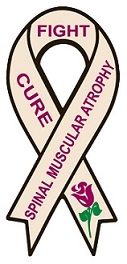What is Spinal Muscular Atrophy (SMA)?
Spinal Muscular Atrophy (SMA) is the number 1 genetic killer of children under 2 years of age. It can strike a person anytime throughout their life - infant, toddler, teen or adult.
SMA is a group of inherited and sometimes fatal diseases that destroy the nerve cells (motor neurons) controlling voluntary movement, such as, crawling, walking, head and neck control, as well as swallowing and breathing. It affects the anterior horn cells located in the spine.
Facts About SMA
- 1 in 40 people are carriers of the SMA gene.
- 1 in every 6,000 live births is affected.
- Over 25,000 people in the USA have SMA.
- SMA does not discriminate when it comes to sex, age, race or ethnic background.
- Generally both parents must carry the SMA gene to have a child affected by SMA.
- There is a 1 in 4 chance of having a child with SMA if both parents carry the gene.
- There is a 50% chance of having a child who carries the gene if both parents carry the gene.
- There is a 25% chance of having a child who carries the gene if one parent carries the gene.
There are 4 types of SMA
- TYPE 1: Type 1 SMA or infantile SMA is also known as Werdnig-Hoffmann disease. It is the most fatal type of SMA. Symptoms begin at birth or in the first few months after birth. Infants diagnosed with Type 1 SMA never reach the milestone of sitting unsupported. The muscles controlling breathing and swallowing are most affected and become weak. Most infants with Type 1 SMA die before the age of 2 but technology has advanced and with the aid of noninvasive (bipap) or invasive mechanical ventilation, airway clearance equipment (cough assist and suction) and feeding tubes some infants diagnosed with SMA Type 1 are living longer.
- TYPE 2: Type 2 SMA is also called Intermediate SMA. Symptoms usually begin around 7 to 9 months of age. Infants with Type 2 SMA are able to sit unsupported but are not able to stand or walk independently. Many infants diagnosed with Type 2 SMA live into adulthood.
- TYPE 3: Type 3 SMA or Mild SMA is also known as Kugelberg-Welander disease. Symptoms usually begin after age 2. Those with Type 3 SMA are able to stand and walk independently but may lose that ability as they get older, during adolescence or even later, sometimes well into their adult years.
- TYPE 4: Type 4 SMA is also called Adult SMA. Symptoms usually begin in the late teens and into adulthood. Those diagnosed with Type 4 SMA live a normal life span.
More Information
For more detailed information on SMA as well a place for support, go to SMA Support.
To search for information or support for other rare diseases (if you are not yet sure of a diagnosis, or the diagnosis does not match SMA) go to Madison's Foundation.


